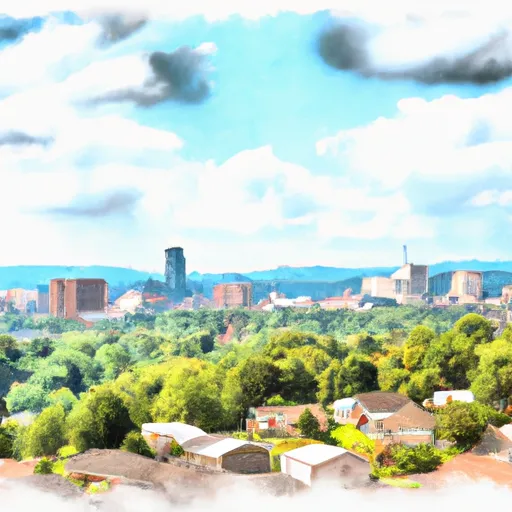-
 Snoflo Premium
Snoflo Premium
Get unlimited access to all our content
With no Ad interruptions! - Start Your Free Trial Login with existing account
Strawberry-Plain
Eden Index
Climate
8.2
•
Recreation
4.0
•
Community
2.9
•
Safeguard
5.4/10

Strawberry-Plain, Tennessee is a small rural community located in Jefferson County, nestled in the eastern part of the state. The region experiences a humid subtropical climate, characterized by hot, humid summers and mild winters. Average temperatures range from the mid-80s Fahrenheit (29°C) in summer to the mid-40s Fahrenheit (7°C) in winter. The area receives moderate rainfall throughout the year, with slightly higher precipitation levels during the summer months.
Hydrologically, Strawberry-Plain is surrounded by numerous rivers and lakes. The nearby French Broad River provides opportunities for boating, fishing, and other water-based activities. Additionally, Douglas Lake, a popular reservoir, is located just a short drive away, offering opportunities for swimming, kayaking, and camping.
Outdoor enthusiasts will find plenty of recreational opportunities in the area. Cherokee National Forest, situated nearby, provides opportunities for hiking, camping, and wildlife viewing. The region is also known for its scenic beauty, with rolling hills, lush forests, and picturesque landscapes, making it a popular spot for nature photography and birdwatching.
Overall, Strawberry-Plain, Tennessee offers a pleasant climate, diverse hydrology, and various outdoor recreation opportunities for residents and visitors alike.
What is the Eden Index?
The Snoflo Eden Index serves as a comprehensive rating system for regions, evaluating their desirability through a holistic assessment of climate health, outdoor recreation opportunities, and natural disaster risk, acknowledging the profound impact of these factors on livability and well-being.
Climate Health Indicator (CHI): 8.2
Strawberry-Plain receives approximately
1181mm of rain per year,
with humidity levels near 84%
and air temperatures averaging around
14°C.
Strawberry-Plain has a plant hardyness factor of
7, meaning
plants and agriculture in this region tend to thrive during the non-winter months.
By considering the ideal temperature range, reliable water supplies, clean air, and stable seasonal rain or snowpacks, the Climate Health Indicator (CHI) underscores the significance of a healthy climate as the foundation for quality living.
A healthy climate is paramount for ensuring a high quality of life and livability in a region, fostering both physical well-being and environmental harmony. This can be characterized by ideal temperatures, reliable access to water supplies, clean air, and consistent seasonal rain or snowpacks.
Weather Forecast
Streamflow Conditions
French Broad-Holston
Area Rivers
French Broad-Holston
Snowpack Depths
French Broad-Holston
Reservoir Storage Capacity
French Broad-Holston
Groundwater Levels
Recreational Opportunity Index (ROI): 4.0
The Recreational Opportunity Index (ROI) recognizes the value of outdoor recreational options, such as parks, hiking trails, camping sites, and fishing spots, while acknowledging that climate plays a pivotal role in ensuring the comfort and consistency of these experiences.
Access to outdoor recreational opportunities, encompassing activities such as parks, hiking, camping, and fishing, is crucial for overall well-being, and the climate plays a pivotal role in enabling and enhancing these experiences, ensuring that individuals can engage in nature-based activities comfortably and consistently.
Camping Areas
| Campground | Campsites | Reservations | Toilets | Showers | Elevation |
|---|---|---|---|---|---|
| Rabun Beach | 82 | 1,846 ft | |||
| Upper Chattahoochee River | 34 | 2,209 ft | |||
| Laurel Park - Lake Lanier | None | 1,118 ft | |||
| Moccasin Creek State Park | None | 1,881 ft | |||
| Lake Russell | 42 | 1,081 ft | |||
| Boggs Creek | 31 | 1,798 ft | |||
| Seed Campground | None | 1,769 ft | |||
| Unicoi State Park | None | 1,678 ft | |||
| Low Gap Creek | 13 | 1,792 ft | |||
| Andrews Cove | 10 | 2,056 ft |
Nearby Ski Areas
Catastrophe Safeguard Index (CSI):
The Catastrophe Safeguard Index (CSI) recognizes that natural disaster risk, encompassing floods, fires, hurricanes, and tornadoes, can drastically affect safety and the overall appeal of an area.
The level of natural disaster risk in a region significantly affects safety and the overall livability, with climate change amplifying these risks by potentially increasing the frequency and intensity of events like floods, fires, hurricanes, and tornadoes, thereby posing substantial challenges to community resilience and well-being.
Community Resilience Indicator (CRI): 2.9
The Community Resilience Indicator (CRI) recognizes that education, healthcare, and socioeconomics are crucial to the well-being of a region. The CRI acknowledges the profound impact of these elements on residents' overall quality of life. By evaluating educational resources, healthcare accessibility, and economic inclusivity, the index captures the essential aspects that contribute to a thriving community, fostering resident satisfaction, equity, and social cohesion.

